After an absence of nearly 3 years, the time has come to restart this blog… I’ve decided to start writing about Brazil as a potential guide to anyone wishing to visit. It will be my opinion which may differ from other’s views.
I welcome ideas for subjects from anyone who comes across the site
English
Chile: Northwards to San Pedro de AtacamaChile: caminho de volta à Santiago
The journey from Valdivia to Santiago would be approximately 800km, but we chose to stop a little under 200 km before Santiago. Once again, we were worried about finding a hotel in the early evening, so we phoned a couple of hotels the previous night to check availability. The first was in the Santa Helena winery, but was fully booked already, so we called the Hacienda los Lingues who had vacancies so we made a reservation.
The drive from Valdivia was completely uneventful, however it was the first and last time that it rained on our trip! The journey probably took around 8 hours including a couple of quick stops for fuel and food etc.
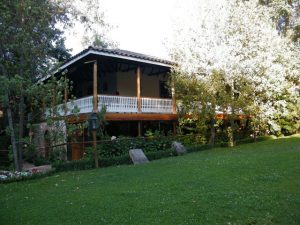
We arrived at the Hacienda and checked in. It looked beautiful and lovely place to stay and there were a lot of cars in the car park. After being shown to our room and ordering dinner (we had to pre-order), we went on an exploratory walk around the grounds and discovered that the vehicles belonged to a film crew shooting a pilot/preview for Chile’s next novella (soap opera). Perhaps we met Chile’s most famous actors, but didn’t know… We then met the manager and one of the owners of the farm. It is owned by the original family who still live there and run the hotel.
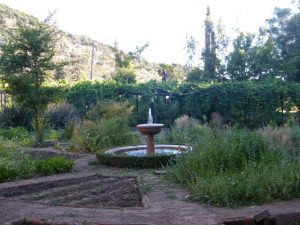
After seeing more, we realised that the hotel wasn’t quite as nice as first appearances and various parts were a little neglected. The price was very for a luxury hotel, but the service didn’t really come up to this level. The dinner was ok, but my order was different from the menu. All in all, not a place I would recommend and the price they were charging.
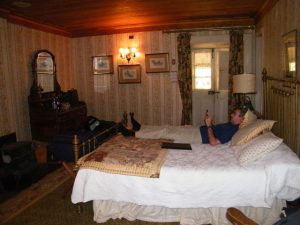
The next day we had to get to Santiago before midday to return the hire car and check-in for our flight to Calama (the nearest airport to San Pedro de Atacama and the city that supports Chile’s largest and one of the the world’s largest copper mines – Chuquicamata). We had pre-booked flights on Sky airlines, Chile’s second biggest airline after Lan Chile. The prices of Sky were much much cheaper than Lan. The only problem with them was that don’t except foreign credit cards on their website, so booking involved phone calls and emails. It all worked out well and I’d thoroughly recommend that others consider making the effort to do this.
The flight to Calama was about two and a half ours with one stop (different cities in each direction). Once again, this was uneventful and we were met by someone that was going to provide the 75 minute transfer from Calama to San Pedro. We had pre-booked this transfer, but I don’t think it was necessary with hindsight.
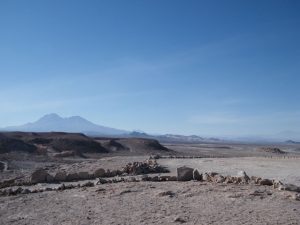
The journey was through the desert on a good road. You leave Calama and go over a mountain range which takes you to height of around 3,400 metres before dropping down into the valley between these mountains and the Andes. San Pedro is at the foot of the Andes on the far side of the valley across the salt lake (more next post). It is a town based around a natural oasis whose water source is in the Andes mountains.
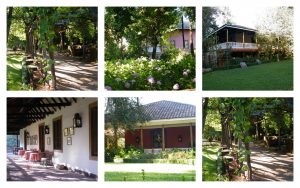
Chegamos à Hacienda Los Lingues depois de um dia de uma viagem bem tranquila desde Valdívia. Ao sair da Ruta 5, não acreditamos nas instruções do GPS e tomamos uma estradinha de terra que nos levou por uns 5 km até a entrada da fazenda. Na verdade, o GPS estava certo (dahn!!) e há um caminho pavimentado que chega ao local. No estacionamento, várias vans e alguns caminhões e eu pensei “ai meu Deus, onde fomos nos meter?”. Mais tarde vimos que havia uma equipe filmando uma novela de época para a televisão chilena nas instalações do hotel.
A fazenda está localizada em uma região muito bonita, tem jardins com árvores centenárias, e uma horta de onde vem a maioria dos produtos servidos nas refeições no hotel, segundo nos informou nosso garçon. A piscina fica fora da ala principal, a alguns metros de distância do portão principal, e nós fomos também a um laguinho de onde se tem uma vista geral das instalações.
Uma das fazendas mais antigas e preservadas do Chile, o lugar é sem dúvida testemunho do dinheiro antigo no país. A casa principal data de meados do século XVIII e é decorada no estilo, com pesados móveis, tapetes, cortinas, papéis de parede floridos e muitos objetos da família em exposição. O quarto em que ficamos nos fez pensar que estávamos no quarto da fazenda da minha bisavó, se ela tivesse uma. Olha só o quarto:
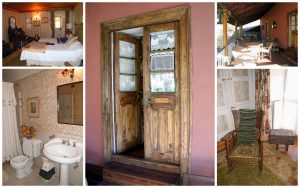
O nosso guia (Rough Guide to Chile 2006) afirmava que o hotel era parte do grupo Relais e Châteaux, mas pelo que vimos não é mais. Percebemos uma certa decadência na fazenda, desde o papel de parede descascado, até a toalha bordada poída e o gerente (na verdade genro do dono) reclamando da interferência da família na condução nos negócios… Enfim, tudo meio surreal!
Na manhã seguinte, partimos diretamente para o aeroporto de Santiago, 150 km ao norte, onde entregamos o carro e embarcamos no voo da Sky Airlines para Calama, com escala em Antofagasta. Apesar de o avião não ser muito novo, a viagem de pouco mais de duas horas foi agradável, no horário, e com um lanchinho de fazer a Gol passar vergonha. Em Calama, já tínhamos contratado com o hotel nosso transfer até San Pedro de Atacama, nossa base no deserto mais árido do mundo.
Outros capítulos da viagem ao Chile:
Nossa viagem ao Chile: primeira parte
Para ver mais fotos, clique aqui.
Para ler o relato do Steve, selecione o idioma inglês.
Chile: Puerto Varas and ValdiviaPuerto Varas e Valdívia
We arrived at Puerto Varas, avoiding Puerto Montt as guide books were not very flattering about the other city in the region, in mid-afternoon. In many ways Puerto Varas is similar to Pucon: it has volcanos (3 or 4 visible on a clear day), it is on the edge of a lake and it is also a popular tourist destination. However, I would describe Pucon as being a little more ‘up-market’, but Puerto Varas is a larger city and probably has more to offer. We had decided to spend 2 nights there.
We checked in to the Licarayen hotel. Once again we were concerned about finding vacancies and this hotel had had good reviews so were pleased to find availability. However, we found it a little simple and nothing special. Breakfast was again particularly uninspiring with instant coffee and a very limited selection. I think we could have found something better, but it was close to a beach and the town centre.
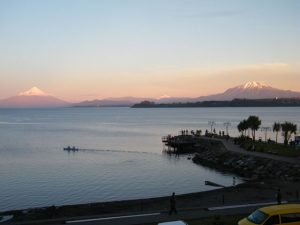
On the day we arrived, there was beautiful sunshine which allowed for some good shots of the Osorno volcano (the closest to the city). The above was taken on our first night. The next morning, however, we awoke to fog with extremely limited visibility and no volcanos to be seen! We were a little tired anyway, so took it easy in the hotel in the morning, but when the cloud started to lift we decided to drive around the lake to get closer to the mountains as Puerto Varas itself is quite flat and not terribly beautiful.
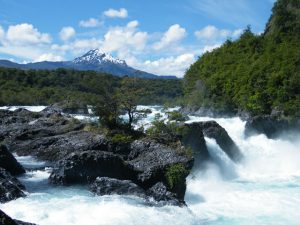
The drive to Petrohue from the centre of the town was only about 50 km. The first half is flat and fairly unspectacular, but the last section is beautiful. Fortunately, as we drove the clouds continued to lift. About 5 km short of Petrohue the paved road runs out at Salto del Petrohue. Here there are a number of cataracts and falls, even though they are not particularly high the volume and proximity to the water makes them impressive.
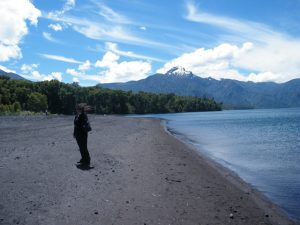
If you carry on along the road you come to Petrohue where you can catch a ferry to take you to Peulla and cross the Andes to Bariloche in Argentina. This would be a beautiful trip, and one I would like to do, but we didn’t have time this trip. Maybe one day we will make it in the reverse direction from Bariloche. Despite not being able to make the crossing, we still found Petrohue to be very beautiful being on the edge of lake, close to Osorno volcano and the source of the Petrohue river that flows over the falls mentioned above. There are places to stay if you want. It is also possible to take a day trip to Peulla by boat from Petrohue, but as we arrived in the afternoon, it was also too late to do this.
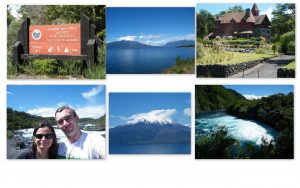 The next morning, we left Puerto Varas to start the long (~1000 km) drive back to Santiago. We decided to stop twice en-route. The first would ideally have been around half-way, but we couldn’t find anything that looked interesting in our guide book so elected to stay in the city of Valdivia which is described as ‘cosmopolitan’.
The next morning, we left Puerto Varas to start the long (~1000 km) drive back to Santiago. We decided to stop twice en-route. The first would ideally have been around half-way, but we couldn’t find anything that looked interesting in our guide book so elected to stay in the city of Valdivia which is described as ‘cosmopolitan’.
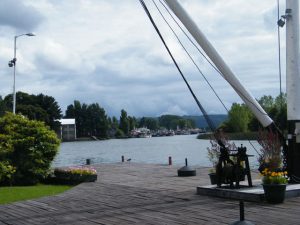
It was a relatively short drive of just over 200 km up the main highway with a 50km turning to the left (west) towards the coast. We mistakenly thought we would see the Pacific Ocean and a proper beach, but alas no! As for cosmopolitan, the only evidence we discovered for this was a Macdonalds and a Chinese restaurant. To say we were disappointed is a total understatement. The pictures may paint a pretty picture, but most of the town was very very different.
We stayed at the Naguilan hotel. The hotel was again clean and comfortable with a slightly better breakfast than a lot of the other hotels, but it was a 20 minute walk from the town centre and located in a poor neighbourhood with a dock for fishing boats a short distance away. Whilst I wouldn’t say don’t stay here as the grounds and hotel are pretty, there is a modern and what appears from the outside to be a much better located hotel in the city centre.
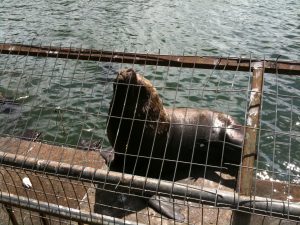
The only other thing apart from an old submarine of indeterminate age and origin that I found interesting in Valdivia was a group of Elephant seals/Sea lions (I don’t know which) that played in the river close to a fish market and hauled themselves out of the river to bask in the sunshine.

Chegamos em Puerto Varas e nos instalamos no Hotel Licarayén, num quarto com frente para o Lago Llanquihue e uma vista dos vulcões Osorno e Calbuco de tirar o fôlego. Nem chegamos a ir a Puerto Montt, já que tínhamos ouvido, mais de uma vez, que não valia a pena esticar a viagem até lá.
Puerto Varas é uma cidade parecida com Pucón, com lagos e vulcões e muitos turistas que aproveitam da infraestrutura da cidade para fazer base e explorar o entorno. O parque nacional Vicente Perez Rosales fica bem próximo, e aí é possível fazer trilhas, caminhadas, e até mesmo escalar o vulcão Osorno.
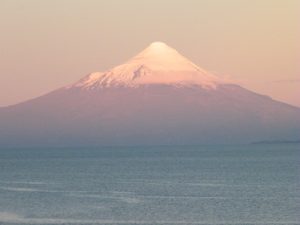
Queríamos ver o Lago de Todos os Santos, de onde começa a travessia para Bariloche, que eu tinha feito há muitos anos, e para lá fomos na tarde seguinte. A estrada vai margeando o lago Llanquihue por uns 40 km, até Ensenada. Daí a paisagem se torna mais bonita, principalmente quando a estrada se encontra com o Rio Petrohué, o rio mais turquesa que já vi. Paramos para ver as corredeiras, chamadas Saltos de Petrohué, logo antes da entrada do Parque Nacional.
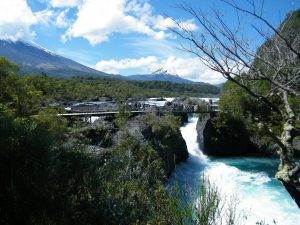
Seguindo por uma estradinha de terra de 6 km chega-se ao ponto final para quem não vai pegar o ferry boat para Peulla e seguir até a Argentina. É o Lago de Todos os Santos, o mais bonito que vimos na região. É chamado de Lago Esmeralda justamente por causa da cor intensa da água. As margens do lago são de uma areia escura, que nos pareceu resultante de uma erupção vulcânica passada.
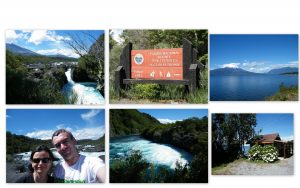
Resolvemos que vamos voltar um dia para fazer a Cruce de Lagos, e completar o passeio que começa aqui em Petrohué. Por ora, tínhamos de voltar a Puerto Varas, para começar, no dia seguinte, nossa viagem de volta a Santiago. Neste trecho iríamos parar em Valdívia, uma cidade que, segundo nosso guia de viagem, compensava o desvio de 50 km a oeste da Ruta 5. Queríamos também ver o Oceano Pacífico, e achamos que esta cidadezinha litorânea seria uma boa pedida. Segundo a descrição do guia, era uma cidade cosmopolita, vibrante, que mistura o colonial com o contemporâneo.
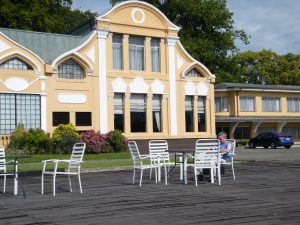
Logo descobrimos que, na verdade, Valdívia não fica no litoral, mas em uma confluência de rios a alguns poucos quilômetros do mar. A cidade também não é tão cosmopolita quanto descreveu nosso guia, mas é uma pequena cidade universitária, que abriga o campus da Universidade Austral do Chile. Como era um período de férias, não havia muito movimento. Gostamos muito do hotel em que ficamos, o Hotel Naguilán, um pouco afastado do centro, mas com um delicioso deque para o Rio Valdívia.
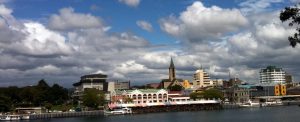
A cidade tem um Mercado Fluvial e, na ilha logo em frente, um Museu Histórico e Antropológico. Há vários barcos ancorados, que fazem passeios pelos rios da região, e levam a algumas fortificações espanholas do século XVII. Nos contentamos em ver os leões marinhos, que aparecem no rio próximo ao mercado para ganhar restos de peixe e tomar um banho de sol. Havia também um misterioso submarino ancorado que, pareceu ao Steve, ser da Segunda guerra mundial.

Para não encarar os 850 km até Santiago, decidimos dormir próximo a San Fernando, e aproveitar nossa última noite novamente no Vale do Colchagua. Minha vontade era ficar no hotel da vinícola Casa Silva, mas estava lotado. Reservamos então uma noite na Hacienda Los Lingues, “uma das haciendas mais antigas e bem preservadas do Chile”, segundo nosso guia. Mas esta história fica para a próxima…
Mais da nossa viagem ao Chile:
Para ver mais fotos, clique aqui.
Para ler o relato do Steve, selecione o idioma inglês.
Chile: Santa Cruz to PuconDe Santa Cruz a Pucón
Following the previous night’s New Year’s ‘festivities’, we got up fairly early, had breakfast, checked out and hit the road around 9:30 a.m. for our 750 km drive south. Unsurprisingly, the roads at this time on New Year’s morning were pretty much deserted.
Santa Cruz is about 40 km west of Chile’s main north-south road 5 which is part of the Pan American highway. Rather than taking the shortest route back to this road, we allowed our GPS to direct us along some country lanes to join the main motorway further to the south. We drove past many more fields of grape vines, but also corn and other crops. I imagine that these crops were Chile’s main produce before Chile’s wine industry really started growing 20-30 years ago.
About an hour later, and only one small error in our GPS’s directions, we were on the main highway heading south at 120 km/h but still with a good 7 hours drive in front of us and no hotel reservation at our intended destination. We had read that this road was good, but I was sceptical, to say the least having got used to Brazilian roads. However, the descriptions were right, the road was excellent and easily up to european standards. From Santiago to Puerto Varas/Puerto Montt it is at least 2 lanes in each direction. The only ‘problem’ were the tolls. There is a toll booth about every 80-100 km and the cost for the whole one-way trip (Santiago to Puerto Varas) was something in excess of 20,000 Chilean Pesos (£25/US$40). Apart from comfort/petrol/gas/food stops, we only stopped once to see an attraction described as a ‘small Niagra Falls’ in our guide book.
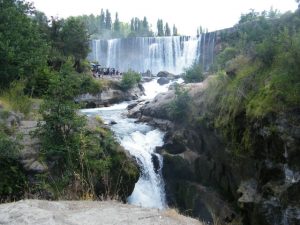
Salta del Laja is a waterfall about half way between Santiago and our southernmost destination of Puerto Varas. We had read about it a little before travelling and had been considering it as a possible overnight stop on the way back. However, we decided to stop on our way south. It was a good decision as the town is very small and extremely touristy. Despite this, the falls were quite impressive but nowhere near on the scale of Foz de Iguacu or even Niagra. For anyone taking a similar journey as us, I would suggest stopping, but only for a short break to stretch the legs etc. It is only a very short diversion from the main road and even used to be visible from the old road before construction of the motorway.
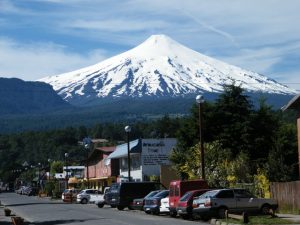
After our stop, we drove straight to Pucon eager to find accommodation. We arrived at Pucon early evening and set about finding a hotel. The first place we enquired was fully booked so we started to get concerned. However, we walked around the main square and found the Hotel Huincahue which had a room. It was quite a nice place with the exception of breakfast which was put out (covered) the night before!
Pucon is a town on the edge of a mountain lake and in the shadow of Villarrica volcano. It is in a really beautiful location with some stunning scenery around. It is reportedly one of Chile’s main holiday destinations. Perhaps consequently, Pucon has a good range of restaurants. We chose an Italian, but found it disappointing. This was not unusual in Chile.
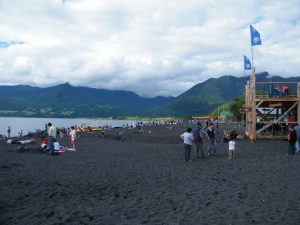
Apart from the beautiful scenery, Pucon also offers a beach. However, as you’ll note from the picture above the sand isn’t golden, instead it is black from the volcanic rock. We didn’t feel tempted to go for a swim, but there were many who do. The other principal attraction in Pucon is an arts market where locals sell all types of things. It is found on the main square and was open the evening we arrived, but closed the next morning as we left too ‘early’ (about 11 a.m.). In fact, we discovered (different to Brazil) that the Chilean day starts late and ends late perhaps as a result of the daylight hours and being on the western side of South America.
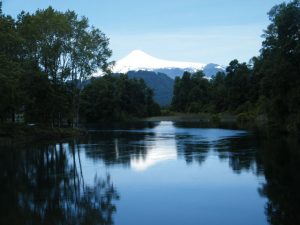
After a quick walk around the town to take some pictures (the ones with sun!), we drove the remaining 250 km or so to our ultimate destination: Puerto Varas. However, once again we decided to start the journey with a scenic detour via Conaripe and Panguipulli. About 40 km of the road was on a dirt road around a lake which we didn’t realise when embarking on it. I don’t like dirt roads much, but this one was suffering just for the views and in truth the road was in very good condition. However, once we were back on the main highway, the stunning scenery was nowhere to be seen. We got to Puerto Varas mid to late afternoon.
As before you can see more photos here and you can read Eneida’s account in Portuguese.Santa Cruz está 30 km a oeste da Ruta 5 (em direção ao Pacífico), em uma estrada de mão única que liga a cidade de San Fernando ao litoral. O nosso hotel estava localizado nesta estrada secundária, a poucos metros da entrada de Santa Cruz. Para voltarmos à Ruta 5 e seguirmos para o sul, resolvemos tomar um caminho diferente por uma estrada vicinal que passa por entre as diversas vinhas da região. Com o auxílio do nosso GPS, a que carinhosamente batizamos de Queenie, chegamos à Teño, de volta à Panamericana que nos levaria à Pucón, 620 km ao sul.
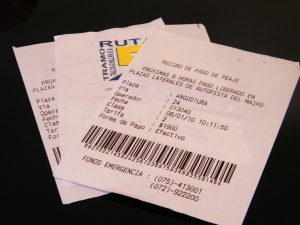
A viagem é bem tranquila, e encontramos a estrada especialmente vazia, devido ao feriado do dia 01/01. Como disse antes, a Ruta 5 é super bem conservada, então dá para justificar os váaarios pedágios que encontramos no percurso. Calculamos que a cada 80-100 km é preciso pagar 1900 pesos chilenos (R$7,00). Fui juntando os comprovantes e, no final da viagem, vi que pagamos mais de 20 pedágios, somando um pouco mais de 40.000 pesos (R$150,00).
Atravessamos o chamado vale central do Chile, a região mais fértil do país, de onde vem grande parte da produção agrícola. Atualmente, a agroindústria toma conta de grande parte da região e, além das vinhas, há plantações de frutas e verduras na maioria do percurso. Durante a viagem até Chillán, especialmente, vê-se enormes galpões de estocagem e processamento de produtos agrícolas. A cordilheira dos Andes, neste trecho, não apresenta montanhas tão altas quanto na região de Santiago ou mais ao norte, mas vez ou outra é possível avistar um pico com neve.
No meio do caminho tinha uma cachoeira…
340 km ao sul de Teño, a poucos metros da Ruta 5, fizemos uma paradinha para conhecer Salto Del Laja, uma cachoeira que, segundo nosso guia de viagem (o livro Rough Guide to Chile, 2006), era uma miniatura de Niagara Falls. Well, me desculpe a cachoeira e o guia, mas tendo estado em Foz do Iguaçu recentemente e conhecendo Niagara Falls, posso dizer que a Salto Del Laja é até bonitinha, mas não é assim nenhuma Niagara. Parece que é um programa popular entre os chilenos, há barraquinhas vendendo souvenirs e estava bem cheio de gente. De qualquer forma, é um lugar para fazer uma paradinha técnica na longa viagem até Pucón.
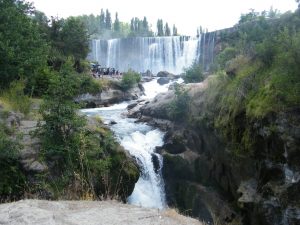
Pucón
Da cachoeira, fomos direto a Pucón, pegando a Ruta 199, já no chamado distrito dos lagos. A partir da cidade de Villarica, são 30 km de estrada margeando o lago Villarica, que oferece aqui e ali belas paisagens. Estávamos apreensivos quanto ao hotel em Pucón. Era feriado, a cidade cheia, e não tínhamos hotel reservado. Resolvemos estacionar na Plaza de Armas e sair procurando. Nossa primeira opção foi o Gran Hotel de Pucón, o hotel mais tradicional da cidade, situado na beira do lago Villarica. Como estava lotado, contornamos a praça e achamos um quarto no Hotel Huincahué, um hotel pequeno e confortável com um quarto bem espaçoso.
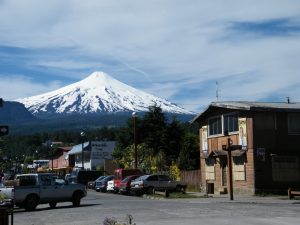
Pucón é uma cidade muito simpática, à sombra do vulcão Villarica, com casas de madeira – um pouco como Gramado. É um destino ideal para os amantes do turismo de aventura, pois de lá é possível: escalar o vulcão Villarica, cavalgar nas encostas do vulcão no Parque Nacional Villarica, fazer rafting nas corredeiras do Rio Huerquehue, pescar nos lagos e rios ao redor da cidade, e muito mais. Nós não fizemos nada disso! Fizemos um passeio até as “praias” do lago Villarica e La Poza, e compramos souvenirs na feira de artesanatos na Plaza de Armas.
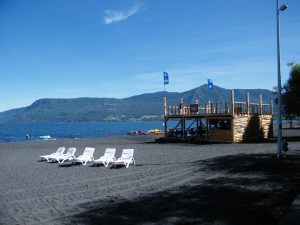
À noite, a cidade é super movimentada, os bares e restaurantes da Av. Bernardo O’Higgins ficam lotados. Ah! e só tem gente bonita, todo mundo magro, de cabelo liso e sorridente. E como são bonitos e simpáticos, os chilenos! Não cruzamos com ninguém mau humorado no nosso caminho. Sempre falam “ya” pra tudo (no castelhano falado por lá “ya” quer dizer sim, ok, tudo bem!).
Os Sete Lagos
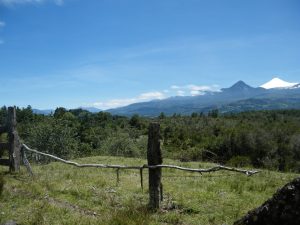
Saindo de Pucón, voltamos em direção à Villarica e de lá, mais uma vez, tomamos uma estrada secundária pela região dos Sete Lagos, que nos levou às paisagens mais bonitas desta parte da viagem. 30 km ao sul de Villarica está o Lago Calafquén e daí rumamos para a esquerda, com direção a Coñaripe. A estrada de terra é bem conservada, nem o Steve reclamou. De Coñaripe, fomos a Panguipulli e de lá voltamos para a Panamericana, na cidade de Los Lagos. O percurso todo, de Pucón à Panamericana, levou umas 2 horas, de lagos e vulcões e rios azuis.
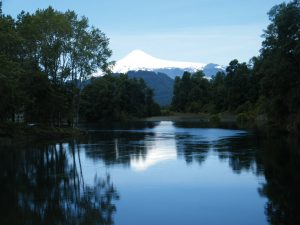
De Los Lagos a Puerto Varas, nossa próxima parada, são 180 km, que foram percorridos em menos de 2 horas. Mas Puerto Varas fica para o próximo post.
Mais da nossa viagem:
Nossa viagem ao Chile (1a parte)
Para ver mais fotos, clique aqui.
Para ler o relato do Steve, escolha a opção “inglês”.
Our trip to Chile (part 1)Nossa viagem ao Chile (1a parte)
Having some time off and some air miles that were about to expire, we asked ourselves “Where shall we go?” Answer: Chile.
The next question was where, specifically. We decided that we would like to visit Santiago, the wine region including some wineries, the south for the scenery and the Atacama for its uniqueness.
Our first night, the night of 29th December, was spent in the Holiday Inn hotel adjacent to the terminal building of the airport having arrived at around 2 a.m.. The next morning, having picked up our reserved hire car (thankfully it was pre-booked as none of the companies had cars left), we drove around 200 km south to the town of Santa Cruz, the main city in the Colchagua Valley – one of Chile’s premium wine production districts.
We had decided to spend about 2 days here. The hotel we chose was Hotel Casa del Campo, a small family run hotel with lots of charm. The owners were incredibly friendly, even driving us to a restaurant as taxis were hard to come by. The only drawback with this hotel was that it was on the outskirts of town and you needed to drive everywhere which wasn’t so convenient for New Year’s Eve given the dearth of local taxis!
The town of Santa Cruz itself is quite small and doesn’t have a huge amount to do. But it does have wineries which are probably some of the best in Chile. Time only allowed us to visit three: Viu Manent, Montes and Clos Apalta, but they were all of differing character.
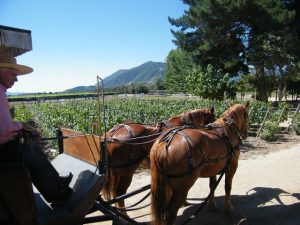
The first, Viña Viu Manent, is one of the oldest producers of wine in the valley and has some of the oldest vines – its speciality being Malbec with vines dating back around 100 years. Formerly, its product was for private/personal consumption of the estates owners, but it now sells internationally as well as domestically. It is one of the smaller wineries, but probably my favourite. The tour encompasses the vineyards, history, a horse pulled carriage ride to the production facility through some vineyards and terminates with the wine tasting.
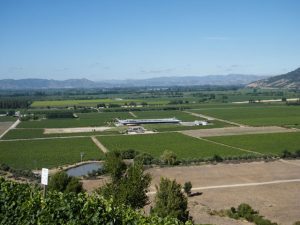
Our second stop was at Viña Montes on the morning of New Year’s Eve. This was the largest of the wineries we visited and was described by our guide as a medium size Chilean winery. Our impression was that it is more of a factory than a family winery. However, the wine produced here was excellent including an excellent Carmenere. The tour consisted of a van drive up onto a hill overlooking the valley and in particular their vineyards. The tour was followed by a trip around the winery itself including the underground facility where they play music to the wine ageing in oak barrels. As always, the tour concluded in the shop with wine tasting.

The final winery was Clos Apalta. This is one of the newest wineries, but perhaps produces the highest quality wines which have received awards. Here the tour consisted only of a tour of the winery itself followed by tasting. The winery is built over a number of floors and the whole production process is done by gravity with the grapes entering at the top, being put into the oak fermentation vats, before being piped down into the cellars into French oak barrels. The entire emphasis here is on the quality of the wine produced. We finished this tour early afternoon of New Year’s Eve.
So, hot to celebrate the arrival of the new year. There were basically 2 options: the main hotel in the centre of town, or the casino a couple of blocks away. We didn’t fancy an expensive set meal in the hotel so elected for the casino, also having spent the previous New Year’s at a less than marvellous party in a hotel in Egypt. However, on this occassion, I think the hotel may have been a better option as the casino was totally empty. The party only started after midnight but we had to leave soon after the clock struck 00:00 as there was a long drive to Pucon facing us the next morning!
Steve
For more pictures, please see our gallery.
For Eneida’s account of the trip, please see the Portuguese version! Fui ao Chile pela primeira vez com minha mãe, quando ainda era adolescente. Fizemos a travessia da Cordilheira dos Andes, de Bariloche à Puerto Montt, e depois voamos para Santiago onde passamos alguns dias. Desde então, voltei à Argentina algumas vezes, mas nunca mais tive oportunidade de voltar ao Chile.
Fui ao Chile pela primeira vez com minha mãe, quando ainda era adolescente. Fizemos a travessia da Cordilheira dos Andes, de Bariloche à Puerto Montt, e depois voamos para Santiago onde passamos alguns dias. Desde então, voltei à Argentina algumas vezes, mas nunca mais tive oportunidade de voltar ao Chile.
Quando resolvemos gastar as milhas que tínhamos para um passeio na América do Sul, o Chile nos pareceu o lugar ideal. Em duas semanas, poderíamos ir de norte a sul, visitar o deserto de Atacama, o vale do Colchagua e a região dos Lagos, de cujas paisagens espetaculares ainda me lembrava. O difícil foi resolver o que deixaríamos para uma próxima ida, como a Ilha de Páscoa, o passeio de navio para ver as geleiras, e a região de Puerto Natales, no extremo sul da Patagônia Chilena.
Decidimos alugar um carro na primeira semana da viagem para viajar para o sul e, na segunda semana, ir ao deserto de Atacama de avião. Ficaríamos um dia em Santiago antes de embarcar de volta ao Brasil.
– Será que vale a pena dirigir de Santiago a Puerto Varas e de volta a Santiago em uma semana?
Foi a pergunta que nos fizemos quando ficamos sabendo que, para devolver em Puerto Varas um carro alugado em Santiago, teríamos que pagar quase o dobro do que pagaríamos se o carro fosse devolvido no local em que foi alugado. Depois de algumas pesquisas, sabíamos que a Ruta 5, estrada panamericana que corta o Chile de sul ao norte, é uma rodovia totalmente duplicada e com asfalto em excelente estado de conservação. Sabíamos também que a distância entre as duas cidades era de aproximadamente 1000 km e que havia alguns lugares interessantes no caminho. O motivo mesmo para querermos ir de carro era poder parar nas cidadezinhas do vale do Colchagua, da região dos lagos e dos vulcões. Queríamos também conhecer uma cidade litorânea.
Então, fazendo as contas, resolvemos encarar os 2000 km de viagem, e embarcar com um roteiro mais ou menos definido, mas que estava aberto a mudanças. Como era altíssima estação (réveillon), reservamos hotel para os dois primeiros dias da viagem (em Santa Cruz, no Vale do Colchagua). De resto, iríamos arriscar.
1a parada: Vale do Colchagua
Tínhamos chegado em Santiago depois de 2:00 da manhã com energia somente para atravessar a rua e cair no Holliday Inn do Aeroporto, que ganhou nota 10 no quesito proximidade do desembarque. Foi ótimo, àquela hora, não precisarmos nos preocupar com táxis, trânsferes, etc. Quando acordamos, atravessamos novamente a rua para buscar o carro que tínhamos reservado para alugar. Sorte. Não havia carros disponíveis em nenhuma locadora para quem não tivesse reserva.

E deixamos Santiago com destino a Santa Cruz, a menos de 200 km ao sul. Pudemos confirmar que a Ruta 5 é mesmo ótima e, ainda melhor, é que os chilenos são extremamente bem educados no trânsito: nos 2.500 km que dirigimos, não vimos nenhum louco passando a 150km/h quando o limite de velocidade é 120km/h e, surpreendentemente, não presenciamos nenhum acidente.

Já estava quase me estressando por não ter levado o endereço do Hotel Casa de Campo, que seria nosso endereço nos próximos dois dias, quando vimos a placa de entrada, a menos de 1 km de Santa Cruz. O hotel, na verdade uma agradável pousada, é mesmo na beira da estrada, mas ficamos muito bem impressionados com a simpatia com que fomos atendidos e com as instalações, que nos fizeram sentir como se estivéssemos mesmo passando uns dias no sítio de um amigo.

Ainda dava tempo para conhecer uma vinícola, e foi o que fizemos. Na loja da Ruta del Vino, na praça principal de Santa Cruz, nos indicaram a vinícola Viu Manent, que fica a poucos quilômetros do hotel, então rumamos para lá. Uma das vinícolas mais antigas da região, tem como especialidade o vinho Malbec, mas gostamos muito do Carménère que nos foi servido na desgustação. O tour inclui um passeio de charrete através das vinhas até a unidade de produção, onde experimentamos o vinho diretamente dos barris, antes de estar pronto para o consumo. Assim, pudemos comparar com o produto maduro que provamos na desgustação. Para mim, que nunca tinha visitado uma vinícola antes, foi muito tudo muito interessante. Mas juro que não consegui sentir no vinho o “retrogosto de tabaco com notas de café” que o guia insistia em salientar.
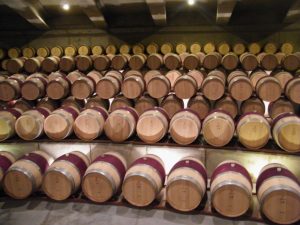
No dia seguinte, último dia do ano, ainda visitamos duas outras vinícolas: a Viña Montes, que nos tinha sido recomendada, e a bonita Casa Lapostolle. Nas duas, o vinho é produzido em instalações moderníssimas sem que precise ser bombeado, pois a forma com que as instalações foram construídas permite que seja transportado sempre pela força da gravidade. Não faço ideia de como isso altera o gosto do vinho, mas, pelo que nos explicaram, parece que é o que há de mais avançado em termos de produção de vinhos.
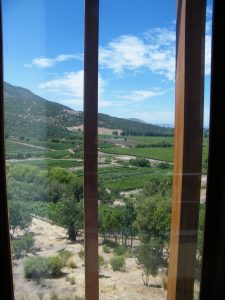
Para o Réveillon, tínhamos duas opções: um jantar no Hotel Santa Cruz, principal hotel da cidade, ou uma ida ao cassino onde haveria música ao vivo. Escolhemos o cassino porque no ano anterior participamos de uma festa no hotel em que estávamos no Egito e não gostamos muito. Fomos para o cassino só mesmo para brindar a meia-noite, pois no dia seguinte teríamos uns 700 km de estrada nos aguardando. E assim, logo depois da entrada de 2010, voltamos para nosso hotel-casa-de-campo.
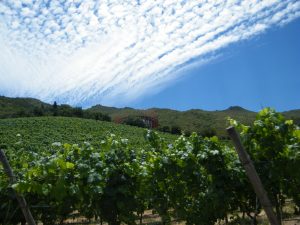
Mais fotos da viagem aqui.
Para ler o relato do Steve, leia a versão em inglês.
Sunny Sunday in INHOTIMUm domingo em INHOTIM
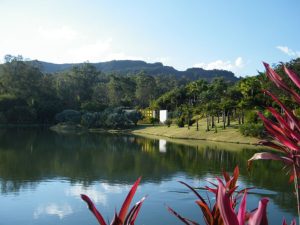
Have you ever heard so much about a place that you think it must be overrated? You’re sure you’re going to be disappointed when you finally see it. That was my feeling about Inhotim, an open-air contemporary art museum 60 km from our home in Belo Horizonte. Last Sunday we eventually managed to go there and I have to say that Inhotim is everything I heard about and more! We loved it.
When we got there, the place was very crowded, because we chose to go on a long weekend right after the opening of new exhibitions. Later I read that on that day, Oct 11th, they had more than 4000 visitors, a record since the opening in 2006. So we stood in line for half an hour or so but we had decided to spend the day there.
The place:
Installations, sculptures and paintings by contemporary artists from the 1960s onwards are part of the permanent collection. Some are outdoors while others are housed in 16 pavilions scattered around the park. According to the museum’s website, there are 600 hectares of Natural Reserve, 45 hectares of gardens with botanical collections and 5 lakes. Nature in its exuberance, as you can see in the pictures below.
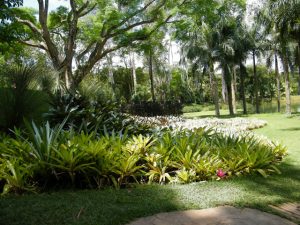
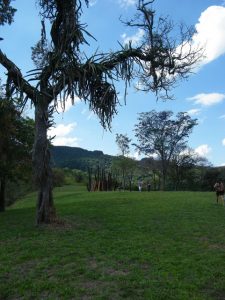
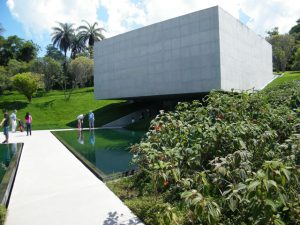
For us Brazilians, some names stand out like that of landscape designer Burle Marx, inspiration for the amazing gardens, and modernist artists such as Helio Oiticica, Amilcar de Castro and movie-maker Neville D’Almeida. I was also surprised to see an installation by Olafur Eliasson, whose work I’d seen in the Turbine hall at Tate Modern back in 2004. And Steve was very impressed with a sound installation by Janet Cardiff with music recorded at Salisbury Cathedral.
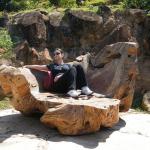
This is a place we are definitely going back, especially with our dear guests from out of state or overseas.
Centro de Arte Contemporânea de Inhotim
Opening hours:
Thursdays and Fridays: 9:30 – 4:30 pm
Saturdays, Sundays and National Holidays: 9:30 – 5:30 pm
Admission for adults: R$15.00
Click here to see how to get there.